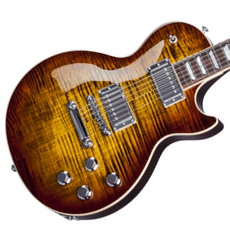 The Gibson Les Paul is one of the most iconic electric guitars in the instrument’s relatively short history. Owning a Les Paul is a right of passage for many players in the rock and blues genres (and even a few in jazz and country). A perennial preferred model is the beloved Les Paul Standard. And though Gibson traditionally offers models that harken back to the company’s earlier offerings, they also never shy away from integrating new technology and challenging convention. For 2017, Gibson decided to offer two iterations of the Les Paul Standard – a “T” model (traditional) and an “HP” model (high performance). I decided to check out the HP model, since I already owned and was familiar with the more traditional Les Paul model. So that demands the question – the “modern” upgrades to the Les Paul HP worth it?
The Gibson Les Paul is one of the most iconic electric guitars in the instrument’s relatively short history. Owning a Les Paul is a right of passage for many players in the rock and blues genres (and even a few in jazz and country). A perennial preferred model is the beloved Les Paul Standard. And though Gibson traditionally offers models that harken back to the company’s earlier offerings, they also never shy away from integrating new technology and challenging convention. For 2017, Gibson decided to offer two iterations of the Les Paul Standard – a “T” model (traditional) and an “HP” model (high performance). I decided to check out the HP model, since I already owned and was familiar with the more traditional Les Paul model. So that demands the question – the “modern” upgrades to the Les Paul HP worth it?
Specifications
The 2017 HP Les Paul features a AAAA flamed maple top in a variety of finishes. The mahogany body is weight-relieved to reduce the instrument’s weight. The “soloist” neck sports a compound-radius fingerboard. The electronics are highly flexible, with Burstbucker Rhythm Pro and Lead Pro+ humbuckers. User-accessible dip switches allow for a wide array of sounds, as do the push-pull volume controls that allow single coil as well as standard humbucker operation. The heel provides easier access to the upper frets, a departure from the traditional Les Paul heel design. The tuners are the improved G-Force system which provides automated standard and alternate tuning. The HP also has a height-adjustable titanium zero-fret nut. The tune-o-matic bridge and tailpiece are also made out of aluminum, rather than the standard chrome plating.
Performance
When first tackling the HP Les Paul, it took me a little getting used to because it doesn’t feel quite like any Les Paul I’ve played in the past, but that’s not a bad thing. The neck is rightly called the “Soloist” because the asymmetrical profile coupled with the high access neck carve really made soloing a breeze, particularly the higher frets. The electronic options available on this model are massive, given that traditionally speaking dual humbucker guitars aren’t necessarily known for their tonal versatility. Personally, I wish I could get the look of a traditional Les Paul coupled with the sonic and playability options of the 2017 HP, but the HP is such a fine modern instrument that the upgrades are well worth it. And though I was hesitant to rust the stock automatic tuners, I have to say – they worked without a hitch. I was able to engage standard and alternate tunings on the fly with nary a tuning error.
Final Thoughts
It’s safe to say that the Les Paul HP won’t appeal to everyone. Traditionalists who like “any color, so long as it’s black” might not be persuaded, but if you’re open to modern improvements on a traditional design, the HP model might just appeal to you. Gibson has made some questionable decisions over the past few years, but you have to give them points for pressing forward and trying new things. Personally, I think the 2017 HP model is a welcome addition to the Les Paul line. Its wide range of sounds and playability make it a solid contender, if you can afford the price of admission of course.
Name of Gear: Gibson Les Paul Standard 2017 HP
List Price: $5.329.00
Manufacturer Info: gibson.com
Pros: Wide array of sounds; excellent playability
Cons: May not appeal to traditionalists
